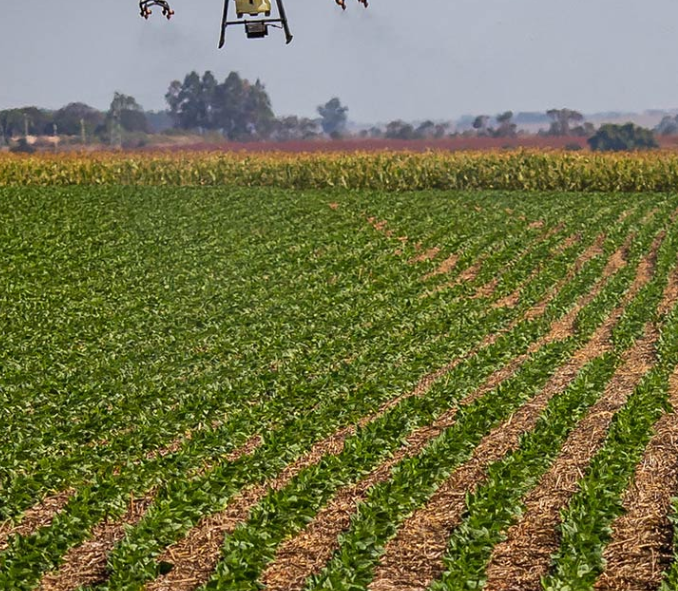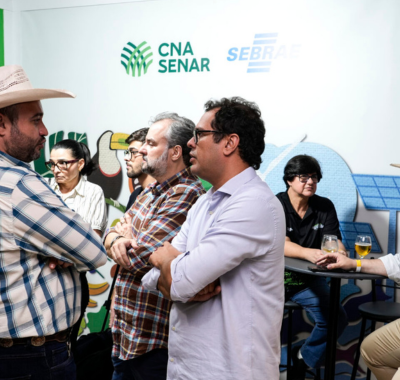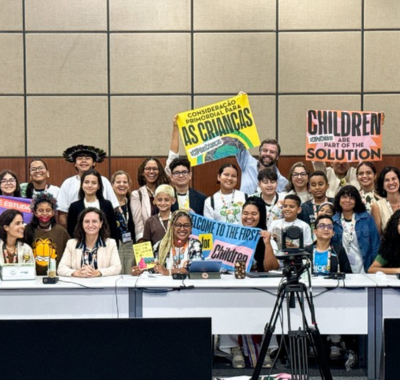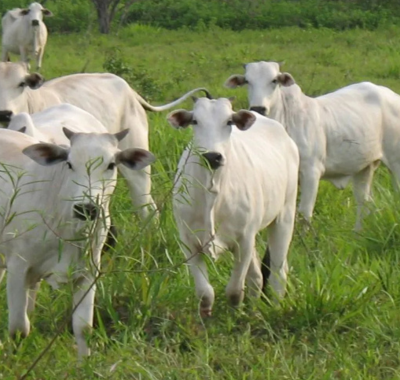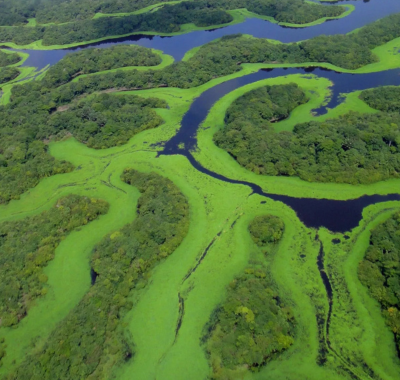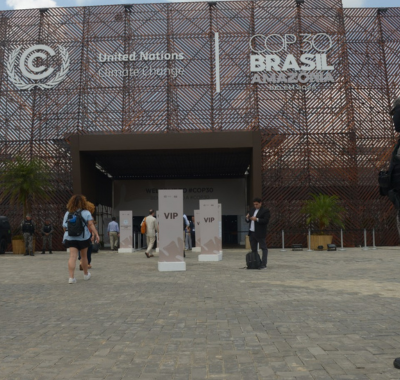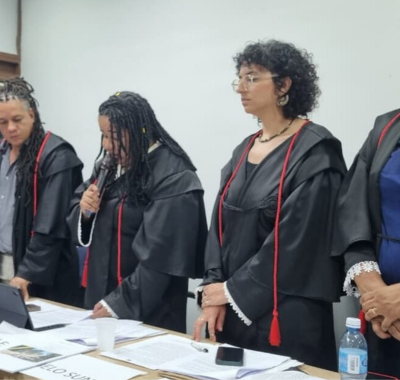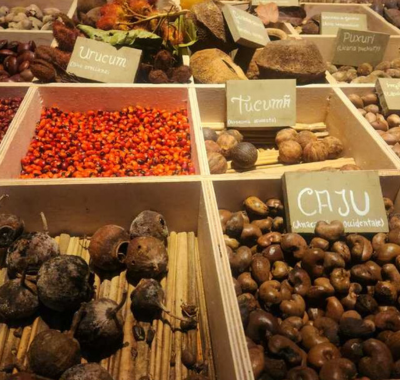Proposals resort to false premises about hunger, food production, land use, and the transition to healthy food systems to suggest the adoption of Brazilian agribusiness methods in the rest of the world.
Authors: João Peres, Tatiana Merlino, and Bruna Bronoski
Translated by Roberto Cataldo/Verso Tradutores
No mention of pesticides or agrochemicals. There is concern for soil health but not for human health. And lots of incomplete or distorted information. This is the summary of the document that organizations representing Brazil’s agribusiness sector sent to COP30 president Ambassador André Corrêa do Lago.
“No one should even agree to discuss it: children and grandchildren without peace? That’s absurd!”, sums up Roberto Rodrigues, former Minister of Agriculture in Lula’s 2003-2007 administration, who coordinated the document’s preparation and is a special envoy of the agriculture sector at COP 30.
The report “Sustainable Tropical Agriculture. Cultivating Solutions for Food, Energy, and Climate” is signed by the Brazilian Forum of Tropical Agriculture, a coalition that gathers some of the most representative organizations in the sector’s lobby, such as Think Agro Institute (IPA) and Brazilian Agribusiness Association (ABAG).
In short, the document is based on two false premises. The first one is quite old in the sector’s views: agribusiness will solve the problem of world hunger. The text itself refutes this principle, admitting that the issue exists because “unequal distribution, systematic waste, and extreme weather events keep millions hungry[RC1] .” The second false premise is recent, selling the idea that large-scale production has already completed a successful transition to fully sustainable production.
The document is not exactly new to those used to the common discourse that large agribusiness sustains Brazil and feeds the world. Still, the fact that it was presented at a UN global climate conference is a clear contradiction. The emphasis on the use of the term “science” is striking, as is the propaganda that the sector has always been highly sustainable.
While the first page speaks of peace, the last one advocates stability and a dream marriage between knowledge and practices. “By combining productivity, social inclusion, and climate action, tropical agriculture is consolidating itself as a pillar of global stability, ensuring affordable food, renewable energy, and climate resilience. Adapting agriculture to this new context goes beyond resisting extreme events. It means transforming production systems, regenerating territories, and renewing our relationship with nature. This transition depends on the integration of science, local knowledge, and public policy – from
soil to landscape and from genetics to biodiversity.”
Solving nonexistent problems
Even though Brazil is the world’s largest consumer of pesticides, the issue does not appear even once in the document. At some points, it mentions bio-inputs, which are products derived from microorganisms, plant extracts, and other biological substances that serve as alternatives to pesticides, chemical fertilizers, and other synthetic farming inputs. What the document does state is the solution to a nonexistent problem. Why are bio-inputs necessary? We don’t know.
Also remarkably absent from the document is the debate on human health. If pesticides are ignored, obviously the problems they cause are also ignored, which means a deafening silence at a time of accumulating evidence about populations affected by pesticides and growing suspicions about the relationship with the skyrocketing number of cancer cases.
But, beyond this direct and visible damage, the document also ignores the need to produce healthy food. It is quite telling that a summary of solutions for the transition to what would be a sustainable and healthy food system ignores the existence of ultra-processed foods and the concern it arouses in the scientific community. At least the Brazilian Forum of Tropical Agriculture had the common sense not to position itself as a spokesperson for agroecology, a word that does not appear in the text.
False premises
The document revives an old promise of large-scale production: peace. This is the theme that inspires Roberto Rodrigues’ entire preface. As he himself advocates, who could oppose peace? And the necessary pathway to it, he says, is to export the Brazilian agricultural model to every little tropical corner in the planet.
“This vision will reach its full potential within the planet’s tropical belt. Latin America, sub-Saharan Africa, and parts of Asia are regions with available land to expand cultivation and where technological standards are still relatively low. It is across this vast territorial expanse that the largest sustainable tropical agricultural production is set to take place, helping to prevent fratricidal wars of any kind,” he proposes.
Producing peace was an important element in the discourse of the Green Revolution – an offensive created in the United States in the second half of the last century. Broadly speaking, the proposal is to produce on a large scale, with low diversity and intensive use of pesticides and fertilizers. This idea is based on Thomas Malthus’s theory, according to which there would not be enough planet to support humankind. The interpretation of this theory in the field of agriculture is that only large-scale production could guarantee survival and peace on the planet.
The problem is that, seven decades later, hunger still exists and has been compounded by escalating incidence of chronic diseases such as cancer, diabetes, and cardiovascular conditions as a result of consumption of harmful products. More recently, it has also become evident that agriculture plays a significant role in creating climate collapse.
But, according to Rodrigues, we need more Green Revolution: “In Sub-Saharan Africa, the absence of research institutions and structured policies maintained low-productivity extensive systems, aggravated by soil erosion and fertility loss. The limited reach of the Green Revolution in the region is evidenced by stagnation in total factor productivity since the 1960s, in contrast to well-above-average global growth observed in Latin America and Asia, with Brazil leading this process.”
Distortions
The report contains a series of false or distorted pieces of information.
“Everything developed here over the past 50 years – from a country that imported 30% of its domestic food in the 1970s to one that now exports agricultural products to over 190 countries – must be presented, explained, and its applicability to the tropical belt clearly demonstrated.”
This is false. We searched through all public documents available about the 1960s and 1970s, and there is nothing to suggest that Brazil was a major importer of food.
“Until the mid-20th century, Brazilian agriculture still bore the marks of its colonial heritage. Extensive systems, low productivity, deep regional inequalities, and heavy dependence on imports of inputs and staple foods defined the sector. The Cerrado, with its 204 million hectares, was considered unsuitable for cultivation due to soil acidity, excess aluminum, and low natural fertility. The rapid urbanization of the 1960s increased the demand for food, leading the country to frequently resort to the foreign market to meet basic needs.”
This part contains a number of inaccuracies. The first problem is that Brazil is still heavily dependent on imported inputs: it does not produce enough fertilizers, nor even all foods that are needed all over the country, such as wheat and corn. The second problem is that the rapid urbanization of the 1960s is partly explained by the displacement of small farmers to make way for large estates. In other words, the urban demand for food production was partially created by the model advocated by the document.
Finally, current agriculture has not broken away from the colonial past. In other words, large agribusiness is heir to the colonial structure of land concentration, land grabbing, violence against peasants and traditional peoples, and privileges in credit and infrastructure construction policies. Large estates are productive, but also a fertile ground for problems.
Unsustainable
The accumulation of distorted information about sustainability is all over the document. Ignoring that almost all deforestation in Brazil is produced by large agribusiness, it attempts to create a narrative full of success, saying that the sector has been key to saving national forests.
While the document does not mention ultra-processed foods, it is abundant in its defense of the other major direct product of the dominant food system: meat occupies considerable space. Nowhere does the document disputes the size of the current – and growing – demand or the role that the sector’s corporations have played in boosting per capita consumption.
In short, “the so-called ‘cumulative land-saving effect’ reaches 397 million hectares, an area that would have been necessary to sustain current production levels if productivity had remained at 1990 levels – equivalent to approximately 2.5 times the country’s current pasture area.”
Even if the agribusiness sector “saved land” in terms of space, which it does not, it still does not save the health of the land. A recent study by Escolhas Institute points to the excessive and growing use of fertilizers in large-scale agricultural production, such as soybeans, of which Brazil has been the main global exporter since 2019.
“The result of this trajectory of transformation is remarkable. In the last three decades, grain production in Brazil has grown 494.8%, from 58 to 345 million tons, while the cultivated area has increased 115.8%, from 38 to 82 million hectares, considering the planted area that includes first, second, and third harvests, depending on the product. This progress reflects significant productivity gains, which have allowed for an estimated ‘area savings’ of 144 million hectares – equivalent to 1.8 times the current area cultivated with grains.”
The country is using more and more phosphorus and potassium in soil, having increased the use of these substances by 299% in 30 years (1993-2022), but output has grown far below that: 64%. In soybean production alone, used to feed pigs and chickens in other countries, Brazil has already dumped more than six million tons of fertilizers in the same period, that is, concentrated chemical substances that end up in rivers that supply traditional populations in rural areas, but also urban populations in large cities.
In terms of sustainability, the document still considers as complete a transition that has not even begun. Basically, the organizations exaggerate the scope of initiatives that are embryonic in the sector, and whose results are uncertain.
“Currently, the Brazilian agricultural sector is undergoing a new transformation, driven by the adoption of regenerative technologies and practices that combine agroforestry systems and integrated food and energy production systems. More than just increasing productivity, this transition seeks to restore soil health, conserve biodiversity, and strengthen the resilience of production systems,
enabling them to operate with low or neutral carbon emissions and, in many cases, remove more carbon from the atmosphere than they emit.” The Forum of Tropical Agriculture did not listen to science to make such statements. Currently, there is no scientific consensus on a protocol for pasture and crop management that ensures efficiency and measures the amount of emissions avoided in the soil by “regenerative practices.” These projects need to be closely monitored by certifiers and project proponents, which could only occur with rigorous on-site inspection of soil management by independent private or public agents – not by companies paid to provide second opinions.
The document also argues that regenerative agriculture and livestock practices are at the forefront of climate action in the agrifood sector. “This new paradigm combines environmental sustainability, economic profitability, and climate resilience, forming one of the central axes of the transition to sustainable tropical agriculture.” However, considering that large agribusiness is responsible for almost 75% of greenhouse gas emissions, how is it possible to be “at the forefront of climate action” without discussing a reduction in the number of cattle head? How can the sector be at the forefront if that number is expected to increase?
The document also points out that “climate finance has established itself as the main historical bottleneck in negotiations and as the decisive enabler of the implementation of the Paris Agreement’s Nationally Determined Contributions (NDCs). COP30 in Belém represents an opportunity to transform this barrier into an effective bridge to action.”
And it states that “national experience with low-carbon agriculture, bioeconomy, and renewable energy proves that sustainability can be a driver of competitiveness and prosperity.”
For a little more gold
A document on agribusiness would obviously not refrain from demanding more and more money. And it argues that market mechanisms are crucial for attracting private investment. In this sense, bioeconomy and carbon markets “convert mitigation actions and sustainable use of natural resources into measurable economic value and create direct economic incentives for decarbonization.” However, reports from Joio and several media outlets have shown how carbon markets use greenwashing strategies and ban traditional ways of life.
In the context of climate finance, the document also suggests the use of capital market instruments to enable “sustainable agribusiness.” Green bonds are presented as a source of resources with “proven environmental benefits.” However, when an agricultural bond is examined up close, the benefits may be nonexistent, if not directly harmful to the environment and forest peoples. This is the case with green bonds that raise billions of dollars for companies to harvest soybeans, corn, and cotton in protected areas such as indigenous lands and territories of traditional peoples.
The document also attempts to revive a financial instrument that has not taken off, even among the agribusiness sector and the financial market: the Green Rural Product Certificate (CPR). Even the CPRs that serve as collateral for issuing green bonds – that is, operations that should justify and guarantee, financially and environmentally speaking, the issuance of the bond – are far from sustainable. Investigations prove that the lack of regulation of and control over these instruments allows the agribusiness sector to benefit from them twice: through greenwashing with the use of green discourse to raise credit and by not having to explain their operations to creditors, since the market does not require environmental guarantees either before or after providing funds.
The Agriculture Parliamentary Fron (FPA) – the political group that distributes the document – did not forged its most-often repeated, recent agenda. One of their justifications for the request to expand Rural Insurance for agricultural producers is the increase in extreme weather events which, they forgot to mention, are mostly caused by land use changes. Therefore, Rodrigues advocates greater insurance coverage – a state subsidy with subsidized interest rates – so that the agribusiness sector is guaranteed that the money invested in its production will be reimbursed in case of hail, extreme rainfall, or prolonged droughts. But they do not mention any recovery of springs, Permanent Preservation Areas, and Legal Reserves that we find destroyed on Brazilian private properties as actions to reduce the effects of climate change. When these legal protection instruments are cited in the text, it is to praise the Forest Code written and voted on by rural landowners in 2012, which loosened socio-environmental protection in Brazil and leaves sensitive areas coveted by agribusiness unprotected, such as the Cerrado.
—
This report was produced by O Joio e O Trigo, through the Collaborative Socio-environmental Coverage of COP 30. Read the original report at:https://ojoioeotrigo.com.br/2025/11/documento-do-agro-para-a-cop-30-ignora-saude-humana-e-desmatamento/

